Inside The New York Botanical Garden
Esther Jackson
Posted in From the Library on August 9 2018, by Esther Jackson
Esther Jackson is the Public Services Librarian at NYBG’s LuEsther T. Mertz Library where she manages Reference and Circulation services and oversees the Plant Information Office. She spends much of her time assisting researchers, providing instruction related to library resources, and collaborating with NYBG staff on various projects related to Garden initiatives and events.
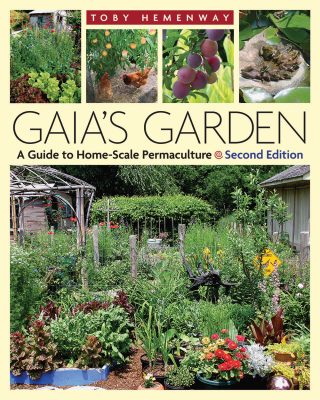 Permaculture is a fascinating topic, but it can be difficult to know where to start looking for information when you are new to the concept and want to learn more. Defined on Wikipedia as “a system of agricultural and social design principles centered around simulating or directly utilizing the patterns and features observed in natural ecosystems,” permaculture has applications in landscape and ecological design, ecological engineering, environmental design, construction, and site maintenance. Two books new to the NYBG Mertz Library, Gaia’s Garden (2009) and The Rodale Book of Composting (2018), offer practical advice for home gardeners who would like to include more sustainable features in their landscapes.
Permaculture is a fascinating topic, but it can be difficult to know where to start looking for information when you are new to the concept and want to learn more. Defined on Wikipedia as “a system of agricultural and social design principles centered around simulating or directly utilizing the patterns and features observed in natural ecosystems,” permaculture has applications in landscape and ecological design, ecological engineering, environmental design, construction, and site maintenance. Two books new to the NYBG Mertz Library, Gaia’s Garden (2009) and The Rodale Book of Composting (2018), offer practical advice for home gardeners who would like to include more sustainable features in their landscapes.
Gaia’s Garden: A Guide to Home-Scale Permaculture (second edition, 2009) is a comprehensive introduction to permaculture principles and projects for the home gardener. Authored by Toby Hemenway, the work is centered on gardening practices in the Pacific Northwest but filled with concepts and projects that are appropriate for gardeners in any region. The ethos in Gaia’s Garden has carried through to many more contemporary gardening books, and this Nautilus Book Awards winner is still a relevant resource for those who are curious to learn more deeply about permaculture principles. One caveat related to the book’s age is that the plant lists should be examined critically before application—several of the recommended non-native species have been found to be problematic since the time of the book’s publication.
Read More
Posted in From the Library on July 26 2018, by Esther Jackson
Esther Jackson is the Public Services Librarian at NYBG’s LuEsther T. Mertz Library where she manages Reference and Circulation services and oversees the Plant Information Office. She spends much of her time assisting researchers, providing instruction related to library resources, and collaborating with NYBG staff on various projects related to Garden initiatives and events.
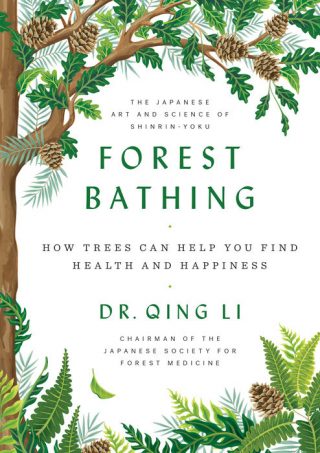 Forest Bathing: How Trees Can Help You Find Health and Happiness, by Dr. Qing Li, is an aesthetically pleasing book about “the Japanese art and science of shinrin-yoku.” Shinrin means “forest” in Japanese, and yoku means “bath.” Shinrin-yoku, then, is the action of “bathing” in the forest atmosphere—of “taking the forest in through our senses.”
Forest Bathing: How Trees Can Help You Find Health and Happiness, by Dr. Qing Li, is an aesthetically pleasing book about “the Japanese art and science of shinrin-yoku.” Shinrin means “forest” in Japanese, and yoku means “bath.” Shinrin-yoku, then, is the action of “bathing” in the forest atmosphere—of “taking the forest in through our senses.”
Li, the Chairman of the Japanese Society for Forest Medicine, writes in a meditative, thoughtful manner, and offers simple advice for those who would like to experience the benefits of forest bathing, either through a more extreme lifestyle change or by incorporating more nature experiences into their everyday lives. With 100 color photographs and large fonts, the book itself is a calming meditation on forest spaces, and a pleasant respite from a day in the office.
The book is beautiful and well-designed, and readers can jump into the text at any point, or read it as a narrative work. Acolytes of forest bathing will want to depart for the woods immediately after reading, but even those without easy access to more natural spaces may be inspired to include more natural outings and experiences as parts of their routines. At NYBG, the Thain Family Forest is calling…
Posted in From the Library on July 5 2018, by Esther Jackson
Esther Jackson is the Public Services Librarian at NYBG’s LuEsther T. Mertz Library where she manages Reference and Circulation services and oversees the Plant Information Office. She spends much of her time assisting researchers, providing instruction related to library resources, and collaborating with NYBG staff on various projects related to Garden initiatives and events.
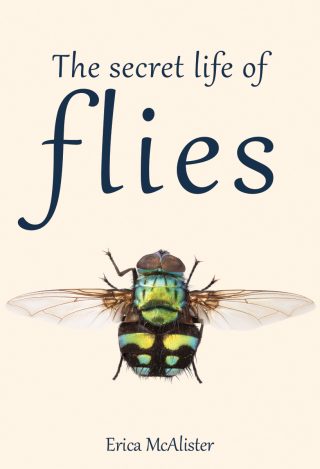 The Secret Life of Flies by Dr. Erica McAlister for Firefly books is fun. It’s a little gross, very entertaining, and all about that insect that so many of us love to hate—the fly! McAlister, a Senior Curator at the Natural History Museum in the United Kingdom, uses her book’s 248 pages to champion these “amazing, exotic and important” creatures. It’s no small feat for an experienced researcher to write in a way that is accessible to a non-scientific audience, and McAlister accomplishes this. When reading her words, one almost feels as if she’s engaging the reader in a conversation, beckoning them closer to look at a maggot that showed up in a most unusual place or at a parasitic fly that prefers the company of frogs.
The Secret Life of Flies by Dr. Erica McAlister for Firefly books is fun. It’s a little gross, very entertaining, and all about that insect that so many of us love to hate—the fly! McAlister, a Senior Curator at the Natural History Museum in the United Kingdom, uses her book’s 248 pages to champion these “amazing, exotic and important” creatures. It’s no small feat for an experienced researcher to write in a way that is accessible to a non-scientific audience, and McAlister accomplishes this. When reading her words, one almost feels as if she’s engaging the reader in a conversation, beckoning them closer to look at a maggot that showed up in a most unusual place or at a parasitic fly that prefers the company of frogs.
The Secret Life of Flies is appropriate for anyone who wants to learn a bit more about these creatures, including younger and older readers who enjoy the sometimes gross and amusing ins and outs of biological study. It’s easy to picture a biology student, an outdoorsy ten-year-old, and an enthusiastic field biologist exclaiming with glee when finding out exactly where that mystery maggot came from. The Secret Life of Flies offers a wonderful window into a world that many of us take for granted and educates readers about an important group of creatures in our natural world.
Posted in From the Library on May 17 2018, by Esther Jackson
Esther Jackson is the Public Services Librarian at NYBG’s LuEsther T. Mertz Library where she manages Reference and Circulation services and oversees the Plant Information Office. She spends much of her time assisting researchers, providing instruction related to library resources, and collaborating with NYBG staff on various projects related to Garden initiatives and events.
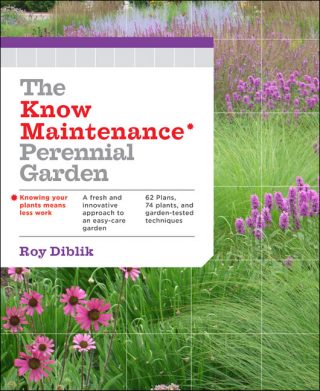 This week’s book review is a #ThrowBackThursday to the popular classic The Know Maintenance Perennial Garden. Written in 2014 by Roy Diblik for Timber Press, the text is a favorite of gardeners who love perennials. Diblik, who worked closely with designer Piet Oudolf on the Lurie Garden in Chicago, has brought his wisdom and knowledge to the public with Know Maintenance. Each of the 62 plans in this work are based on a 10’x14′ grid that is modular in design, offering home gardeners many combinations and plants to suit their landscape and needs, regardless of whether their space is larger or smaller than the example grid. The plans are inspired by works of art as well as existing gardens (for example, Monet, Great Dixter, and Swarthmore College), and are divided into two sections for areas with sun and shade. In addition, plant profiles for 74 plants offer readers suggestions for different plants to use in existing gardens or as a part of new plantings.
This week’s book review is a #ThrowBackThursday to the popular classic The Know Maintenance Perennial Garden. Written in 2014 by Roy Diblik for Timber Press, the text is a favorite of gardeners who love perennials. Diblik, who worked closely with designer Piet Oudolf on the Lurie Garden in Chicago, has brought his wisdom and knowledge to the public with Know Maintenance. Each of the 62 plans in this work are based on a 10’x14′ grid that is modular in design, offering home gardeners many combinations and plants to suit their landscape and needs, regardless of whether their space is larger or smaller than the example grid. The plans are inspired by works of art as well as existing gardens (for example, Monet, Great Dixter, and Swarthmore College), and are divided into two sections for areas with sun and shade. In addition, plant profiles for 74 plants offer readers suggestions for different plants to use in existing gardens or as a part of new plantings.
Read More
Posted in From the Library on May 8 2018, by Esther Jackson
Esther Jackson is the Public Services Librarian at NYBG’s LuEsther T. Mertz Library where she manages Reference and Circulation services and oversees the Plant Information Office. She spends much of her time assisting researchers, providing instruction related to library resources, and collaborating with NYBG staff on various projects related to Garden initiatives and events.
 Therapeutic Gardens: Design for Healing Spaces is a 2015 book by Daniel Winterbottom and Amy Wagenfeld for Timber Press. The authors draw on a body of research that suggests nature and gardens can be healing spaces for people with disabilities and illnesses. However, they also pose the question—is every garden a therapeutic garden? The authors follow this question with a quote from Rodale: “Gardens are where people and the land come together in the most inspiring way.” This is the guiding sentiment throughout the book, making it a useful resource for horticultural therapists, those who would like to design gardens with accessibility in mind, and those who are interested in learning more about the health benefits of many different kinds of gardens.
Therapeutic Gardens: Design for Healing Spaces is a 2015 book by Daniel Winterbottom and Amy Wagenfeld for Timber Press. The authors draw on a body of research that suggests nature and gardens can be healing spaces for people with disabilities and illnesses. However, they also pose the question—is every garden a therapeutic garden? The authors follow this question with a quote from Rodale: “Gardens are where people and the land come together in the most inspiring way.” This is the guiding sentiment throughout the book, making it a useful resource for horticultural therapists, those who would like to design gardens with accessibility in mind, and those who are interested in learning more about the health benefits of many different kinds of gardens.
Starting with a historical sketch about therapeutic gardens, proceeding chapter titles include “Collaborative Design,” “Gardens for Movement and Physical Rehabilitation,” “Gardens for Solace and Comfort,” “Learning Gardens,” “Sensory Gardens,” and “Community Gardens,” ending with a section about garden maintenance. Throughout the text, the authors highlight different successful therapeutic gardens within each category, including gardens for children with cancer, gardens for homeless populations, and peace gardens. For those who believe in the healing power of nature, or those who are interested in the history of therapeutic garden design and philosophies, Therapeutic Gardens is a great resource and a fascinating book.
Posted in From the Library on May 1 2018, by Esther Jackson
Esther Jackson is the Public Services Librarian at NYBG’s LuEsther T. Mertz Library where she manages Reference and Circulation services and oversees the Plant Information Office. She spends much of her time assisting researchers, providing instruction related to library resources, and collaborating with NYBG staff on various projects related to Garden initiatives and events.
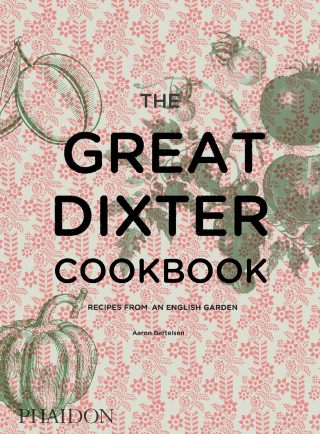 Great Dixter is known for its bountiful and beautiful vegetable garden. The garden has been the subject of a blog by gardener Aaron Bertelsen since 2013, and now it is the centerpiece of The Great Dixter Cookbook: Recipes from an English Garden by Bertelsen with photographs by Andrew Montgomery for Phaidon. On gardening and cooking, the author writes: “Both cooking and gardening require a willingness to learn from experience and to adapt what you are doing … both cooking and gardening offer tremendous scope for creativity … as with everything at Great Dixter, neither the vegetable garden nor the kitchen ever stands still.”
Great Dixter is known for its bountiful and beautiful vegetable garden. The garden has been the subject of a blog by gardener Aaron Bertelsen since 2013, and now it is the centerpiece of The Great Dixter Cookbook: Recipes from an English Garden by Bertelsen with photographs by Andrew Montgomery for Phaidon. On gardening and cooking, the author writes: “Both cooking and gardening require a willingness to learn from experience and to adapt what you are doing … both cooking and gardening offer tremendous scope for creativity … as with everything at Great Dixter, neither the vegetable garden nor the kitchen ever stands still.”
Part cookbook and part gardening book, The Great Dixter Cookbook is filled with beautiful photographs of food, plants, and gardening. Approximately 70 pages address gardening topics while 136 pages are devoted to recipes. Gardening sections include chapters on growing fruits and vegetables as well as a garden diary with suggested garden chores for each of the four seasons. The recipes section includes breakfast, soups, mains, salads and side dishes, biscuits, cakes and desserts, preserves, and basic recipes for foods like stock and pastries.
Read More
Posted in From the Library on April 24 2018, by Esther Jackson
Esther Jackson is the Public Services Librarian at NYBG’s LuEsther T. Mertz Library where she manages Reference and Circulation services and oversees the Plant Information Office. She spends much of her time assisting researchers, providing instruction related to library resources, and collaborating with NYBG staff on various projects related to Garden initiatives and events.
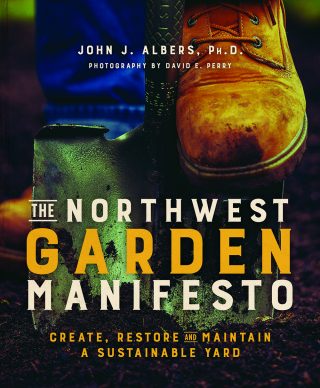 I have a soft spot for gardening books from the Northwest, and so although I live on the East Coast, The Northwest Garden Manifesto: Create, Restore, and Maintain a Sustainable Yard by John J. Albers, Ph.D. (photography by David E. Perry), for Mountaineers Books/Skipstone, is right up my alley. In Northwest, Albers has provided a book that is part instructional and part manifesto. The basics of garden (or “yard”) design are addressed, but the focus is on ecology and sustainable land management. While not explicitly a permaculture guide, Northwest includes useful information about topics such as composting, solar energy, and wildlife habitats. Although the plant recommendations are most appropriate for the Northwest, gardeners throughout the United States will find Albers’s book useful and informative. It is an especially appropriate book for someone who is considering becoming more hands-on with garden or yard care, and wants to understand how a person or community can affect positive ecological change.
I have a soft spot for gardening books from the Northwest, and so although I live on the East Coast, The Northwest Garden Manifesto: Create, Restore, and Maintain a Sustainable Yard by John J. Albers, Ph.D. (photography by David E. Perry), for Mountaineers Books/Skipstone, is right up my alley. In Northwest, Albers has provided a book that is part instructional and part manifesto. The basics of garden (or “yard”) design are addressed, but the focus is on ecology and sustainable land management. While not explicitly a permaculture guide, Northwest includes useful information about topics such as composting, solar energy, and wildlife habitats. Although the plant recommendations are most appropriate for the Northwest, gardeners throughout the United States will find Albers’s book useful and informative. It is an especially appropriate book for someone who is considering becoming more hands-on with garden or yard care, and wants to understand how a person or community can affect positive ecological change.
Read More
Posted in From the Library on April 18 2018, by Esther Jackson
Esther Jackson is the Public Services Librarian at NYBG’s LuEsther T. Mertz Library where she manages Reference and Circulation services and oversees the Plant Information Office. She spends much of her time assisting researchers, providing instruction related to library resources, and collaborating with NYBG staff on various projects related to Garden initiatives and events.
 Aerial Geology: A High-Altitude Tour of North America’s Spectacular Volcanoes, Canyons, Glaciers, Lakes, Craters, and Peaks is a beautiful book by Mary Caperton Morton for Timber Press. Continuing with the publisher’s trend to offer more books on ecological and non-botanical scientific topics, Aerial Geology focuses, as the title states, on geology, the science of the earth’s physical structure and substance.
Aerial Geology: A High-Altitude Tour of North America’s Spectacular Volcanoes, Canyons, Glaciers, Lakes, Craters, and Peaks is a beautiful book by Mary Caperton Morton for Timber Press. Continuing with the publisher’s trend to offer more books on ecological and non-botanical scientific topics, Aerial Geology focuses, as the title states, on geology, the science of the earth’s physical structure and substance.
After a brief introduction to the discipline of geology, Caperton Morton showcases 100 “geological wonders” in North America arranged by geographic region, shot from above. Sometimes the prospect of domestic tourism seems daunting, but Caperton Morton is here to remind readers about the incredible North American landscape as a way of encouragement. Aerial Geology includes geological history and information about each feature, offering readers a richer understanding of the landscape than a coffee table book would provide. However, it must be said that the most eye-catching aspect of the book is its glorious photographs.
Although written for adults, Aerial Geology is the kind of book that science-minded young readers of a more advanced level would also enjoy. For all readers, Aerial Geology offers an introduction to geology and a reminder that these spectacular landscapes are, if not just around the corner, relatively close to home.
Posted in From the Library on April 10 2018, by Esther Jackson
Esther Jackson is the Public Services Librarian at NYBG’s LuEsther T. Mertz Library where she manages Reference and Circulation services and oversees the Plant Information Office. She spends much of her time assisting researchers, providing instruction related to library resources, and collaborating with NYBG staff on various projects related to Garden initiatives and events.
 The Budget-Wise Gardener: With Hundreds of Money-Saving Buying & Design Tips for Planting the Best for Less is a new book by Kerry Ann Mendez with St. Lynn’s Press. Mendez holds class in the “Academy of Shrewd Plant Hunters” teaching readers how to purchase great plants for less, delving into topics including how to find good plant sources, design ideas with low-cost, high-performance plants, and container gardening on a budget. The information in Budget-Wise is presented in a conversational way, and the book is especially useful for those who are looking for advice about questions to ask and what to look for when purchasing plants from a store or online. Mendez’s advice about plant selection is useful for those who are on a budget and for those who are simply interested in learning more about buying plants. A great deal of the information is common sense for those who already regularly purchase plants, but the book is a good resource filled with information and tips, and even experienced gardeners may take away a new idea or two.
The Budget-Wise Gardener: With Hundreds of Money-Saving Buying & Design Tips for Planting the Best for Less is a new book by Kerry Ann Mendez with St. Lynn’s Press. Mendez holds class in the “Academy of Shrewd Plant Hunters” teaching readers how to purchase great plants for less, delving into topics including how to find good plant sources, design ideas with low-cost, high-performance plants, and container gardening on a budget. The information in Budget-Wise is presented in a conversational way, and the book is especially useful for those who are looking for advice about questions to ask and what to look for when purchasing plants from a store or online. Mendez’s advice about plant selection is useful for those who are on a budget and for those who are simply interested in learning more about buying plants. A great deal of the information is common sense for those who already regularly purchase plants, but the book is a good resource filled with information and tips, and even experienced gardeners may take away a new idea or two.
Read More
Posted in From the Library on April 3 2018, by Esther Jackson
Esther Jackson is the Public Services Librarian at NYBG’s LuEsther T. Mertz Library where she manages Reference and Circulation services and oversees the Plant Information Office. She spends much of her time assisting researchers, providing instruction related to library resources, and collaborating with NYBG staff on various projects related to Garden initiatives and events.
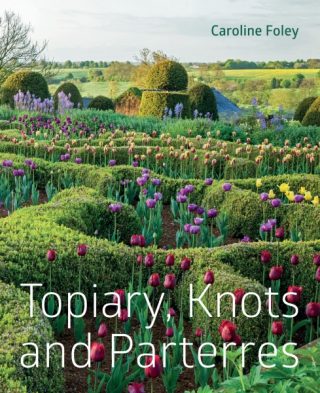 Topiary is back! Or maybe it never really left. In Topiary, Knots and Parterres, author Caroline Foley writes about the history of these garden features and how they are utilized in contemporary landscapes.
Topiary is back! Or maybe it never really left. In Topiary, Knots and Parterres, author Caroline Foley writes about the history of these garden features and how they are utilized in contemporary landscapes.
Published by Pimpernel Press in association with the European Boxwood and Topiary Society, the book gives a comprehensive account of topiary as art and landscape. Presented chronologically, Topiary takes readers from the Patrician Gardens of Rome (AD 79–476) to the art forms and landscape designs envisioned and created by 21st-century gardeners. For those who love formal gardens, topiaries, knots, and parterres feel like familiar friends in new and historic landscapes. Foley, who has edited Topiarius—the pan-European journal of the European Boxwood and Topiary Society—for the past twelve years, covers much ground and provides readers with an excellent book. For those who love topiary or those who want to learn more about its usage in the landscape, historic and contemporary, Topiary, Knots and Parterres is a wonderful resource and engaging work.
Scholars of landscape design history will also appreciate the many historic designs and gardens featured in the book; the LuEsther T. Mertz Library here at NYBG holds many of the historic garden works featured in Topiary. Readers who are curious about historic garden design works at NYBG can learn more about these books in Flora Illustrata: Great Works from the LuEsther T. Mertz Library of The New York Botanical Garden, edited by Susan M. Fraser and Vanessa Bezemer Sellers and published in 2014.
 Permaculture is a fascinating topic, but it can be difficult to know where to start looking for information when you are new to the concept and want to learn more. Defined on Wikipedia as “a system of agricultural and social design principles centered around simulating or directly utilizing the patterns and features observed in natural ecosystems,” permaculture has applications in landscape and ecological design, ecological engineering, environmental design, construction, and site maintenance. Two books new to the NYBG Mertz Library, Gaia’s Garden (2009) and The Rodale Book of Composting (2018), offer practical advice for home gardeners who would like to include more sustainable features in their landscapes.
Permaculture is a fascinating topic, but it can be difficult to know where to start looking for information when you are new to the concept and want to learn more. Defined on Wikipedia as “a system of agricultural and social design principles centered around simulating or directly utilizing the patterns and features observed in natural ecosystems,” permaculture has applications in landscape and ecological design, ecological engineering, environmental design, construction, and site maintenance. Two books new to the NYBG Mertz Library, Gaia’s Garden (2009) and The Rodale Book of Composting (2018), offer practical advice for home gardeners who would like to include more sustainable features in their landscapes.








